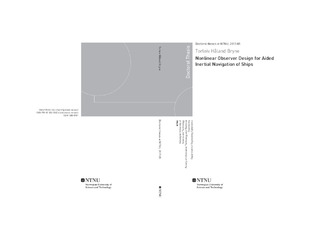| dc.description.abstract | This thesis focuses on strapdowninertial navigation systems for marine vessels, exploiting low-cost micro-electro-mechanical-systems (MEMS) inertial sensors and nonlinear observers for sensor fusion. The motivation behind the research is to investigate the possibility to develop cost-effective inertial navigation systems providing, roll, pitch and heave estimates, similar to typical maritime vertical reference units (VRUs), while providing estimates of the vessel’s position, velocity and attitude as well. In addition, such systems should be fault tolerant.
Nonlinear observers serve as alternatives to the well established extended Kalman filter where explicit stability properties are more cumbersome, and in some cases impossible, to achieve. The presented observers are proven to have semiglobal exponentially stability properties, where semiglobality is mainly due to the infeasibility of pure global results when considering attitude estimation of the special orthogonal group of order three. The observers are benchmarked in full-scale experiments using an established navigation suite based on the extended Kalman filter. Similar performance was obtained in state-state conditions.
The observer designs are based on a framework of a nonlinear attitude observer and a translational motion observer, which forms a feedback interconnection. This is extended to incorporate a virtual vertical reference (VVR) measurement for vertical aiding of the inertial navigation system. The reference signal is utilized as an alternative to vertical measurements from position references such as global navigation satellite systems (GNSS). The inclusion of the virtual reference facilitates high-performance heave estimation. The VVR is also beneficial w.r.t. to attitude estimation improving the roll and pitch estimates by exploiting kinematics couplings between the orientational and the translational motion. In addition to including the VVR in the inertial navigation system, the observer structures are further extended to employ time-varying gains. Moreover, the VVR concept is improved utilizing an error model based on sea-state-dependent parameters. Simulations indicate that the industry standard VRU performance specification of five centimeters or five per cent root-mean-square heave error is obtainable with the proposed design. The presented observer structure are also validated using sensor data gathered on an offshore vessel in operation.
Access to the mean motion of the vessel prevents unwanted motion compensation by the control system. Therefore, marine surface craft often apply wave filtering of position and heading measurements in order to reconstruct the mean motion of the vessel, by attenuating the oscillatory motion components, due to waves, embedded in the measurements. In this work, wave filtering based, on estimated and measured signals from the inertial navigation system and inertial sensors, is presented. The presented work is the first to do so, serving as an alternative to traditional observer-based approaches exploiting ship models.
The thesis also consider fault tolerance and sensors redundancy using nonlinear observers. Concepts for fault detection and isolation using position, heading and inertial measurement are presented based on triple-redundant sensor configurations and nonlinear observers. Outcomes related to weighting and averaging of multiple sensor systems are also presented. In contrast to the VRU systems on board offshore vessels, where the measurements often are average on the output, this theses also focuses on weighting directly on the underlying inertial measurements before these are utilized as to estimate the VRU solution. In addition, position, velocity and heading estimates are also obtained with the approach proposed. Hence, the thesis provides a more integrated design compared to the current industrial practice, that is relying on more separated sensors. The fault tolerance properties of the concepts for redundant inertial measurement units (IMUs), are validated using inertial sensors data gather at sea, injected with artificial faults.
In addition, the dissertation presents a study on the difference between loosely and tightly coupled integration in the context of nonlinear observers and on how these can be implemented in discrete time. Using data gather during an unmanned aerial vehicle flight, results related to the performance difference between these two integration techniques, based on measurements from a MEMS IMU and a standalone GNSS receiver, relative to a real time kinematic GNSS positioning solution, are presented.
Finally, the algorithms presented in this thesis have the potential to be implemented and used commercially on ships and on other types of marine surface vessels. The concepts presented have the potential to increase fault tolerance. Multiple MEMS IMUs have to be installed in order to achieve this, however, these combined with the presented methods have the potential to replace existing VRU solutions. Therefore, the cost might be reduced, while the navigation system’s performance and its fault-tolerance properties may be increased. | nb_NO |
